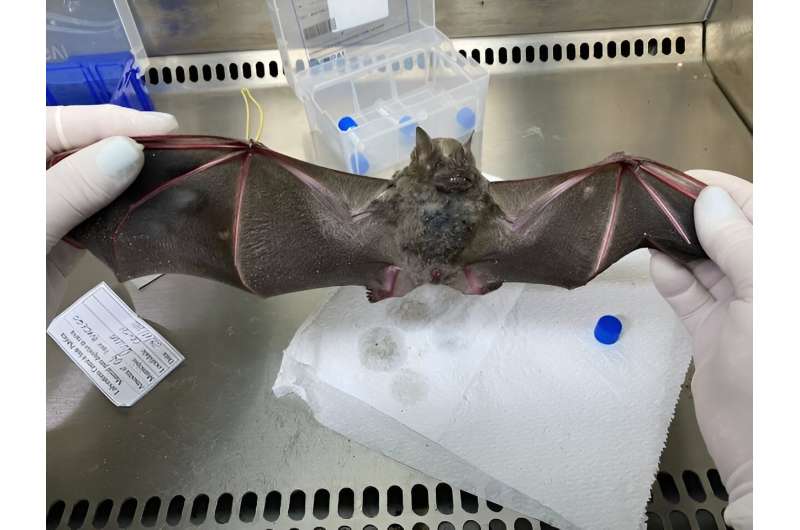This article has been reviewed according to Science X's editorial process and policies. Editors have highlighted the following attributes while ensuring the content's credibility:
fact-checked
trusted source
proofread
Rabies virus variants from marmosets found in bats

Rabies virus variants closely related to variants present in White-tufted marmosets (Callithrix jacchus) have been detected in bats in Ceará state, Northeast Brazil.
Rabies is a deadly disease for humans. Its emergence in distinct wildlife species is a potential source of human infection and hence a public health concern. Marmosets are common in forests and conservation units throughout Brazil. In or near urban areas, they are often captured as pets and later abandoned. They have been linked to cases of human rabies.
An article about the study is published in the Journal of Medical Virology.
Besides the similarity between the variants found in marmosets and the bats analyzed by the researchers, they were struck by the presence of the virus in fruit- and insect-eating bat species. Bats that feed on blood are considered more frequent hosts and important transmitters of rabies.
"Seven marmosets have recently tested positive for rabies. Rabies is endemic in Ceará, where people have been attacked by marmosets and died from rabies. One such death occurred in May," said Larissa Leão Ferrer de Sousa, a Ph.D. candidate at EPM-UNIFESP and a veterinarian at the Ceará Central Public Health Laboratory (LACEN-CE) in Fortaleza.
This death resulted from an attack on a 36-year-old farm worker in February near a town called Cariús. The man went to a health clinic in April, when symptoms started to appear but died shortly afterwards. Infection by rabies virus causes progressive encephalitis, a rapid inflammation of the brain that leads to death in almost 100% of cases.
"The marmoset fell into his backyard. It was semi-paralyzed, which is one of the symptoms of rabies. The man tried to help it, and it bit him. Animals with rabies aren't always aggressive and don't necessarily foam at the mouth, the symptom most people associate with rabies. Sometimes there are no apparent symptoms at all," she said.
People should never touch bats or other wild animals, Sousa warned. Anyone who finds a dead wild animal should alert the local animal health surveillance agency, which will collect the remains for analysis. If they do have direct contact with the animal, they must immediately go to the nearest health clinic to be vaccinated against rabies and/or be given anti-rabies serum.
"Rabies incubates for 45 days on average, so it's extremely important for anyone who's infected to get post-exposure prophylaxis [serum and vaccine] immediately. When symptoms appear, it's normally too late, and the patient will die," said Ricardo Durães-Carvalho, a researcher at EPM-UNIFESP.
Genetic sequencing
The researchers analyzed 144 brain tissue samples from 15 bat species. The animals arrived at LACEN-CE between January and July 2022 as part of the national epidemiological surveillance program, which requires health workers to collect mammals found dead or with symptoms of rabies in Ceará.
RNA extracted from the samples was sequenced, and the genetic sequences for rabies virus were compared with sequences deposited in public databases. The researchers used computer-assisted tools to trace the evolutionary history of the viruses they found.
The first set of sequences was compatible with rabies virus variants found in 2010 in Tadarida brasiliensis and Nyctinomops laticaudatus, insectivorous bat species from Southeast Brazil. However, another group of variants first found in bats (two insectivorous and one frugivorous species) were very close in evolutionary terms to the virus detected in marmosets from the Northeast.
"Our results allowed us to infer that the different rabies virus variants that were closely related in evolutionary terms were originally from the same animal, revealing complex spillover dynamics and multiple viral transmission between hosts," Durães-Carvalho said.
Since vaccination of domestic animals became widespread, wild animals have been the main source of human rabies in the Americas. The first death from rabies linked to a marmoset was reported in 1991, also in Ceará. Since then, 14 other deaths in the same state have been attributed to transmission by these primates.
Bats and marmosets may be key links in the rabies transmission chain in Brazil, but both play important ecological roles and are suffering from habitat loss due to urban and agricultural expansion.
Bats in particular are important to ecosystem equilibrium, and fundamental to seed dispersal, pollination and pest control. "It's best to respect these animals and leave them alone to live in the wild," Sousa said.
More information: Larissa L. F. de Sousa et al, Rabies virus variants from bats closely related to variants found in marmosets (Callithrix jacchus), a neglected source of human rabies infection in Brazil, Journal of Medical Virology (2023). DOI: 10.1002/jmv.29046



















